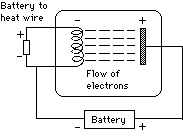History of Computers - The Edison Effect
Page by: Evan Woodham
Many scientists discovered the Edison effect, also known as Thermionic Emission. Edison, however, was the first to point interest in the phenomenon’s direction, and encouraged other scientists to explore it.
Contents
Overview
Fredrick Guthrie in Britain initially reported the Edison effect in 1873. Other contributors were Hittorf, Goldstein, and Elster and Geitel. Thomas Edison, however, rediscovered the effect on February 13, 1880, while trying to discover the reason for breakage of lamp filaments and uneven blackening of the bulbs in incandescent lamps. Edison created an experiment in which he connected a metal electrode to a lamp filament through a galvanometer. When the foil was given a more negative charge than the filament, no charge flowed between them. This is because the cool foil emitted few electrons, a fact Edison could not know because he conducted this experiment before J. J. Thompson’s research on electrons in 1897. However, when the foil received a more positive charge than the filament, negative charge flowed from the filament though the vacuum to the foil. This electron flow is known as the Edison Effect. (Now Thermionic Emission)[1] The Thermionic Diode was made soon after Edison’s work, a machine used to detect radio waves.[1] But it wasn’t until after J. J. Thompson’s identification of the electron that the British physicist Owen Willards Richardson began work on the topic that he coined as Thermionic Emission.
How the Edison Effect Works

The air in a bulb is vacuumed out. A metal coil is added to one end of the bulb, and a metal plate to the other. A battery is added below as shown to make the coil negatively charged and the plate positively charged. Another battery must be added behind the coil to make the current flow. The second battery heats the coil, emitting the electrons that are attracted by the positive charge of the metal plate, completing the current.[2]
Richardson’s Law
In a metal, there are usually electrons willing to move from atom to atom. Occasionally, one of these electrons will have enough energy to leave the atom, the amount of energy being the work function. The work function is usually about several electrovolts strong. This can be encouraged by applying various oxide coatings to the wire.
In 1901, Richardson published the results of his experiments; the current from a heated wire depends exponentially on the temperature of the wire with a mathematical equation similar to the Arrhenius equation. Later, he changed his mind, deciding that the emission law has the mathematical form <math> J=A_{\mathrm{G}}T^2\mathrm{e}^{-W \over k T}</math>
This translates into: emission’s current density= (Ag is explained later) times (thermodynamic temperature of the material squared) times (energy) times –(work function of the metal) divided by (Boltzmann’s constant times the thermodynamic temperature of the material)
Ag is: <math> A_{\mathrm{G}} = \; \lambda_{\mathrm{R}} A_0</math>
λR is a correction-specific factor that is usually .5, and A0 is a constant given by another long equation that includes the mass and charge of the electron, as well as Planck’s constant.
The equation was added to again in 1930, in order to add another correction factor due to the band structure of the emitting material.[1]
<math>J = (1-r_{\mathrm{av}}) A_0 T^2 \mathrm{e}^{-W \over k T}</math>
 An illustration of Schottky's Equation
An illustration of Schottky's Equation
Schottky Equation
In electron emission devices such as electron guns, thermionic electron emitters are usually more negative due to their surroundings. This negativity creates an electric field of magnitude F at the emitter’s surface. The electron field lowers the surface barrier by ΔW urfa, and increases the emission effect. This is known as the Schottky effect or field enhanced Thermionic emission.[3]
This gives the equation
- <math>J (F,T,W) = A_{\mathrm{G}} T^2 e^{ - (W - \Delta W) \over k T}</math>
This gives the equation
- <math>\Delta W = \sqrt{e^3 F \over 4\pi \epsilon_0},</math>
An equation also important in electronics as it helps determine the electronic field.
Significance
These equations are of fundamental importance in electronics, and thus of all computers, who would not be able to run without this discovery. The discovery of the Edison Effect allowed computers to use electrical signals to communicate instead of manual switches. If computers were still manual, it would be impossible for computers to be anywhere near where they are today.
Links
http://en.wikipedia.org/wiki/Thermionic_emission On All Thermionic Emission related things
http://www.geocities.com/bioelectrochemistry/schottky.htm Schottky
http://arc.iki.rssi.ru/mirrors/stern/Education/welect.html How Thermionic Emission works